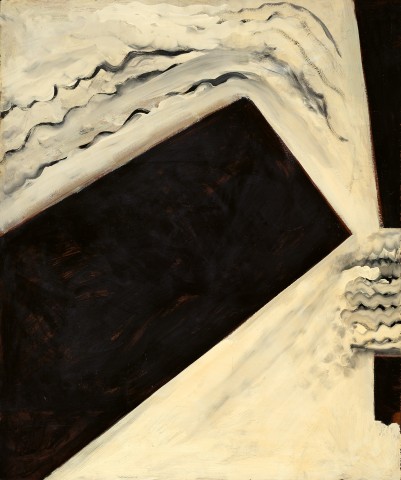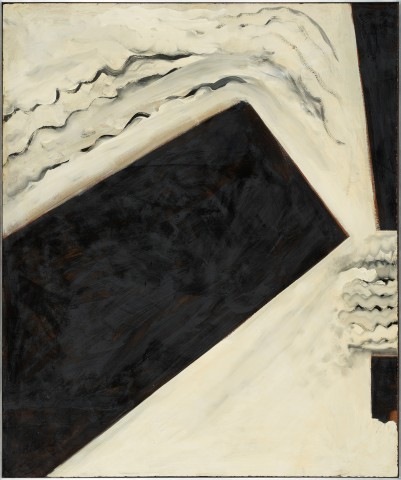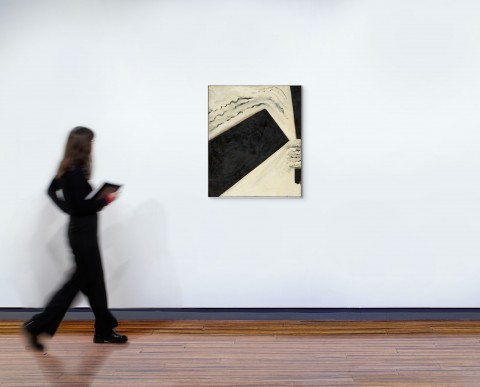FLOODGATE I, 1964 - 65
COLIN MCCAHON
oil on composition board
91.0 x 76.5 cm
signed and dated lower left: McCahon '64 '65
signed, dated and inscribed verso: Colin McCahon. / FLOODGATE I / 1964 1965
Peter McLeavey, Wellington, New Zealand
Rosalie Gascoigne, Canberra, acquired from the above in 1983
Thence by descent
Private collection, Canberra
From the Studio of Rosalie Gascoigne, Australian National University, Drill Hall Gallery, Canberra, 5 September - 12 November 2000, cat. 39
Gascoigne, M., Rosalie Gascoigne. A Catalogue Raisonné, ANU Press, Canberra, 2019, pp. 74, 327
Colin McCahon Online Catalogue, https://www.mccahon.co.nz/cm001466 [accessed 16/5/23]
Floodgate 2, 1965, enamel on hardboard, 102.0 x 68.9 cm, private collection
In late 1983, survey shows by New Zealander Colin McCahon and New Zealand-born Australian sculptor Rosalie Gascoigne were shown simultaneously at the National Art Gallery in Wellington. Rosalie Gascoigne Sculpture 1975 – 1982 (11 works) was her first exhibition in the land of her birth; Colin McCahon: The Mystical Landscape was a survey featuring 36 works, mostly from the extensive holdings of his work at the National Art Gallery.
Gascoigne went to New Zealand for the occasion and, evidently impressed by McCahon’s work, purchased from the stockroom of Peter McLeavey, his Wellington dealer, the present work painted 20 years earlier: Floodgate 1, 1964 – 65. It was one of a pair – the other being Floodgate 2, 1965 – which, McCahon informed McLeavey, belonged to his wife, Anne. Neither work seems ever to have been publicly exhibited in his lifetime.
The year 1964 was one of significant change for McCahon. After twelve busy years as keeper and deputy director at Auckland City Art Gallery (1953 – 64) he resigned to take up a teaching position at the School of Art in the University of Auckland – a position he held for seven years before retiring to paint full-time in 1971. The change immediately led to new developments in his work. In particular, he began a vast series of waterfall paintings, ranging in size from very small to very large; around 100 of them are shown on the McCahon Online Catalogue.1 The exhibition Small Landscapes and Waterfalls at Auckland’s Ikon Gallery in September 1984 was virtually a sell-out and marked a sudden increase in popularity for the artist.
The Floodgate paintings can be seen as a development of the waterfall motif in that they also depict flowing water, but not as a curving arc in profile as seen in most of the Waterfall series, but from above – as in a bird’s eye view or architectural plan. A second element in the Floodgates is the large rectangular black shapes whose hard edges and right angles suggest things man-made, rather than natural hill shapes as in most of the Waterfalls; these, presumably, are the ‘floodgates’. As the titles suggest, these black shapes relate closely to the abstract Gate paintings of earlier in the decade (1961 – 62) – and – in juxtaposing natural and man-made elements – more distantly to On building bridges: triptych, 1952. In the Gate series, dark quasi-rectangular shapes are both barriers (political, social, artistic, spiritual, formal) and openings or ways through. In Floodgates, by fusing the imagery of these contrasted series – gates, waterfalls – McCahon translates the imagery of barriers and openings to a landscape-related context, thereby melding abstraction and realism in a new way.
Here the squarish Floodgate 1 is dominated by the large black rectangular form thrusting diagonally upwards from bottom left towards upper right, the shape being dramatically cropped by the frame. A second black form, narrow and tapering, extends from the top down the right side of the painting. The small gap between them, through which (in a landscape reading) creamy white water is turbulently gushing, is the focal point of the painting. Agitated water also enters horizontally into the picture from the right. Turbulence is suggested by dark wavy lines running through the billowing foam, debouching into a calmer less agitated region in the bottom right segment of the work. Everything about the painting is angular, asymmetrical, dynamic – conveying a sense of vast and barely controllable forces. It is an authoritative and forceful painting, unique (with its sibling) in its imagery, but at the same time integral through its connection to earlier series to McCahon’s evolving direction. Indeed, Rosalie Gascoigne showed bold and refined taste in choosing it for her collection.
1. www. mccahon.co.nz
PETER SIMPSON


